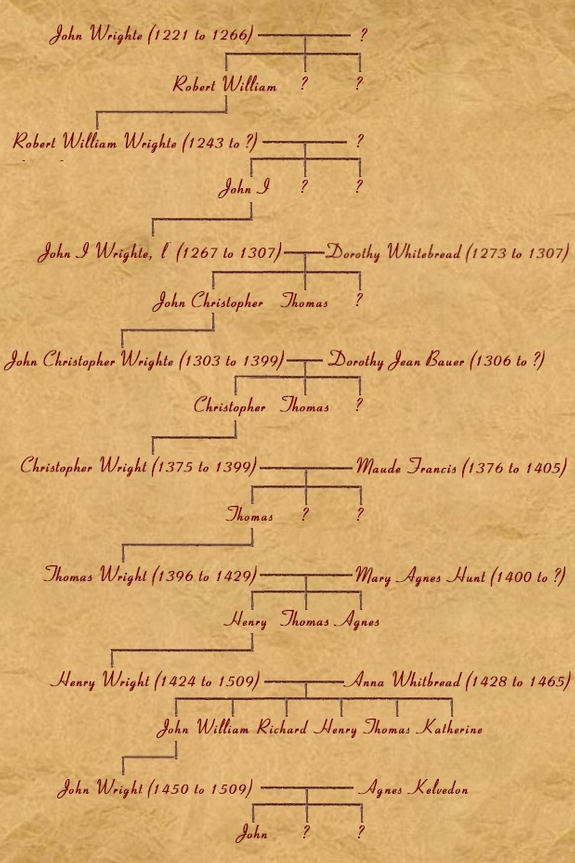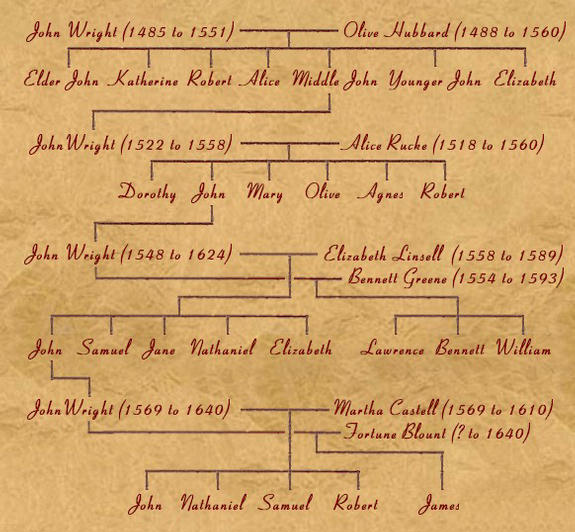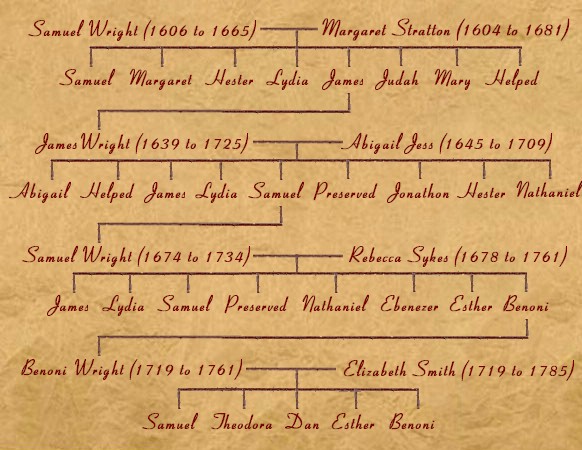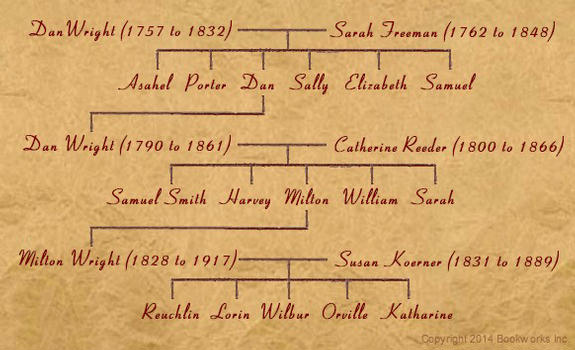|

 Up
Up 
 Wright
Wright
Genealogy 
(You are here.)
 Down
Down




  Need
to Need
to
find your
bearings?
Try
these
navigation aids:
If
this is your first
visit, please stop by:
Something
to share?
Please:




|
|
Available in Française, Español, Português,
Deutsch, Россию, 中文,
日本, and others.
 ishop
Milton Wright was a dedicated genealogist who boasted that he could
trace his ancestry back eleven generations to “his
great-grandfather’s great grandfather,” Sir John Wright, Lord of
Kelvedon Hall in Essex County, England, born 1485, died 1551. And
the Bishop had cause to be proud. In the days before the Internet
and the massive online collections of family records that are
available to us in the twenty-first century, genealogical research
depended on notes kept in a family Bible, hints from family letters
and oral traditions, and correspondence with far-away clerics and
government officials who often had better things to do than answer a
query about a long-dead parishioner or citizen. For Milton to trace
his family back through four centuries and across two continents was
a singular accomplishment in his day. ishop
Milton Wright was a dedicated genealogist who boasted that he could
trace his ancestry back eleven generations to “his
great-grandfather’s great grandfather,” Sir John Wright, Lord of
Kelvedon Hall in Essex County, England, born 1485, died 1551. And
the Bishop had cause to be proud. In the days before the Internet
and the massive online collections of family records that are
available to us in the twenty-first century, genealogical research
depended on notes kept in a family Bible, hints from family letters
and oral traditions, and correspondence with far-away clerics and
government officials who often had better things to do than answer a
query about a long-dead parishioner or citizen. For Milton to trace
his family back through four centuries and across two continents was
a singular accomplishment in his day.
Today we know a great deal more about the
Wright lineage and ancestry; more than the Bishop could ever have
imagined. Because the Internet provides a way for far-flung people
to instantly share information, genealogical and biographical
information accumulates quickly. In Milton’s day there was a trickle
of information, today there is a flood. The problem becomes not
whether we can find information about an ancestor, but whether we
can trust it. The river of digital information that flows around us
is full of tall tales, half-truths, and downright lies. All
information must be carefully winnowed to separate the facts from
the fictions. Consequently, genealogy today is not just a quest but
a science. Family histories evolve as new information is examined
and proven, sometimes replacing older and less reliable traditions.
We don’t just know more than Bishop Milton Wright, we tell the story
of the Wright Family differently than he would have told it.
The Wright family descended from the
Normans who settled in
Normandy in northern France before 1000 C.E. These peoples were
Saxon Vikings that had originally come from northern Germany and the
Jutland peninsula – "Norman" was Old French for "Norse men." After
settling in France, these Saxons invaded the British
Isles and set up small kingdoms such as Sussex, Wessex, and Essex.
These medieval kingdoms united in 924 and called themselves
"England."
In 1066, the English throne passed to Harold Godwinson of Wessex who
became King Harold II. William, Duke of Normandy claimed that the
throne had been promised to him and gathered an army to invade
England. This army was equipped in part by
John Wryta of
Bayeux, a renowned armorer and skilled craftsman in metal and wood.
The army also included John's sons – John, Richard, William, Henry,
and Thomas Wryta. William defeated Harold and became King William I
(better remembered as William the Conqueror). For their part in the
conquest, the Wrtya brothers were given lands in the old Saxon
kingdoms of Norfolk, Essex and Sussex which, under Norman rule,
became English counties.
We don't know which of the Wryta brothers was the ancestor of Wilbur
and Orville Wright. We do know however, that the Wright clan
prospered in England. The surname morphed from Wryta to Wryte to
Wrighte and finally Wright as the family grew and spread out over
the British Isles. But hundreds of years later, the Wrights of Essex
County were certain that they were Norman in origin and had
descended from the Wryta family of Bayeux.

The first person we can say with any certainty was a direct ancestor
of the Wright brothers was John Wrighte, who was born in Lincoln in
Lincolnshire County, England in 1221. He did not stay in northern England for
long, however -- the records show he died in Nazeing in Essex
County. With the exception of his son Robert William and his grandson John I., who spent time
in northern England, most of his progeny resided in Essex and London
County towns and villages such as Upminster, Dagenham, White Notely, and Kelvedon Hatch.
They were members of the upper (Norman) class; many wore the titles of
Lord, Lady, Sir, and even Countess. Two of them served as clerics in the Catholic Church -- there was no
Church of England or any other Protestant sect at this time.

- John Wrighte of
Lincoln, Lincolnshire County (b. 1221, d. 1266) married (?) and
sired at least one child, Robert William.
- Robert William Wrighte was born and died in Nazeing, Essex County (b.
1243, d. ?) married (?) and sired
at least one child, John I.
- Lord John I. Wrighte, I of Stapleford,
Nottinghamshire County (b. 1267, d. 1307) married Lady Dorothy
Whitebread (b. 1273, d. 1307) and had at least two children,
John Christopher and Thomas.
- Lord John Christopher Whitebread-Wrighte of White
Notley, Essex County, (b. 1303, d. 1399) married Lady Dorothy
Jean Bauer (b. 1306, d. ?) and sired at least two children,
Christopher and Thomas.
- Lord Christopher Wright of White Notley, Essex County
(b. 1375, d. 1399) married Lady Maude Countess Francis and sired
at least one child, Thomas.
- Lord Thomas Wright of Essex County (b. 1396, d.1429)
married Lady Mary Agnes Hunt (b 1400, d. ?) and sired three
children, Henry, Thomas, and Agnes.
- Reverend Henry Wright of Upminster, Essex County (b.
1424, d. 1509) married Anna Whitbread (b. 1428, d. 1465) in 1448 and
the couple had six children – John, William, Richard, Henry,
Thomas, and Katherine.
- Reverend Sir John Wright
of Dagenham, Essex County
(b. circa 1450, d. 1509) married Agnes Kelvedon circa 1480. They
had several children, one of which was called John.
Reverend Sir John Wright's son, John Wright, apparently did King
Henry VIII a solid, supporting his request to the Pope to have his
marriage to Catherine of Aragon annulled. Then when the Pope
refused, he supported the King when Henry broke from Rome and installed
himself as the head of the new protestant Church of England. As a result, Henry
knighted John, gave him a title, and generally made
life sweet for him. John was able to build a huge manor house, Kelvedon Hall,
near Kelvedon Hatch in Essex County and purchased over 2000 acres
nearby to create a large estate. His sons and grandsons were part
the landed English gentry, heavily involved in politics, and very
protestant.

-
Sir John Wright, Lord of Kelvedon
Hall, Essex County (b. 1485, d. 1551), married Olive
Hubbard of Dagenham, Essex County (b. 1488, d. 1560) in 1508.
John and Olive had seven children – John the Elder, Katherine,
Robert, Alice, John the Myddle, John the Younger, and
Elizabeth.
- John (the Myddle) Wright of Kelvedon Hall, Essex
County (b. 1522, d. 1558) married Alice Rucke of Kelvedon Hatch,
Essex County (b. 1518, d. 1560) in 1541. They had six children –
Dorothy, John, Mary, Olive, Agnes, and Robert
- Lord John Wright of Wrightsbridge, Essex County (b.
1548, d. 1624) married Elizabeth Linsell (b. 1548, d. before
1589) in 1568. She bore him five children – John,
Samuel, Jane, Nathaniel, and Elizabeth – then died sometime
before 1589. He married again in 1589 to Bennett Greene of
London (b. 1554, d. about 1593) who bore three more children --
Lawrence, Bennett, and William.
-
John Wright, Esq. of Wrightsbridge,
Essex County (b. 1569, d. 1640) married Martha Castell (b.1569,
d. 1610) in 1594. They had fours sons together – John,
Nathaniel, Samuel, and Robert. Martha died in 1610 and
John remarried in 1618 to a widow, Fortune Blount (nee
Garraway, b. ?, d. 1640). She bore him one child, James.
Both John Wright, Esq. and his son Samuel were Puritans at a time when
things were tough for Puritans in England. Puritanism was a quest
for further reform in the Church of England. It began shortly
after Elizabeth I came to the English throne in 1558 and was
tolerated from many years, then openly despised and repressed when
Charles I became king in 1625. Puritans began to flee England and
Samuel joined what became known as the "Great Migration."
He sailed to
America with 20,000 other like-minded souls who hoped to establish a "nation of
saints" in the New World. Samuel settled in Springfield,
Massachusetts and the Wright family remained in that general area
of New England until after the American Revolution.

- Deacon Samuel Wright of Wrightsbridge, Essex County
(b. 1606, d. 1665) married Margaret Stratton (b.
circa 1604, d. 1681) in 1625. While still in England, they had four
children – Samuel Jr., Margaret, Hester (or Esther), and Lydia.
About 1636, they sailed to America where they had four more –
James, Judah, Mary and Helped.
- James Wright of Springfield Massachusetts (b. 1639,
d. 1725) married Abigail Jess (b. 1645, d. 1709) in 1662 and
they had nine children – Abigail, Helped, James, Lydia,
Samuel, Preserved, Jonathan, Hester, and Nathaniel.
- Samuel Wright of Northampton, Massachusetts (b. 1674,
d. 1734) married Rebecca Sykes (b. 1678, d. 1761) in 1697 and
they had eight children – James, Lydia, Samuel, Preserved,
Nathaniel, Ebenezer, Esther, and Benoni.
- Benoni Wright of Lebanon, Connecticut (b. 1719, d.
1761) married Elizabeth Smith (b.1719, d. 1785) and had five
children – Samuel, Theodora, Dan, Esther, and Benoni.
The American Revolutionary War opened up regions to the west of the American colonies to
settlement and development. Benoni's son Dan, a soldier in the
Revolution, decided to take advantage of this turn of events and
moved his family to the Northwest Territory, where his sons and
grandsons pioneered the new states of Ohio and Indiana.

- Dan Wright Sr.
of Lebanon, Connecticut (b. 1757, d. 1832), who married Sarah Freeman
(b. 1762, d. 1848) in 1785 and had six children – Asahel, Porter, Dan Jr., Sally (or Sarah), Elizabeth,
and Samuel.
- Dan Wright Jr. of Thetford, Vermont (b. 1790, d. 1861), who
married Catherine Reeder (b. 1800, d. 1866) in 1818 and had five
children – Samuel Smith, Harvey, Milton, William, and Sarah.
- Bishop Milton Wright of Rush County, Indiana (b. 1828, d.
1917) married Susan Koerner (b. 1831, d. 1889) in 1859. They had five
children – Reuchlin, Lorin, Wilbur, Orville, and Katharine. Susan
also gave birth to twins, Otis and Ida, who died in infancy.
For more biographical information about any of these Wright
ancestors, click on their name. If you would like to read the complete
history of the Wright family so far as it is known, we have
collected these biographies into a printer-friendly PDF file,
A Genealogical History of the
Wright Family.
|

The known Wright family lineage, from John Wryta (circa 1050 CE) to
Wilbur, Orville and their siblings.
|